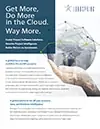4 Ways to Prevent Cloud App Performance Issues
Are you prepared for a worst-case scenario like a sudden lack of cloud application availability or unexpected data overages that incur punitive fees not included in the budget?
According to Tech Target, the four key indicators of ecosystem health are performance, reliability, security, and costs & billing. While continuous monitoring of multiple factors may seem intimidating, it is manageable—especially if you have a team of experts backing you up.
We’ll examine each indicator of cloud performance in depth, considering best and worst-case scenarios for each.
Measuring Cloud Application Performance
Imagine system capacity needs that outweigh application data allocation, resulting in a temporary lack of application availability for the critical members of your team when you need access to data the most.
Cloud application performance can be a complicated process, but it doesn’t have to be. We recommend beginning by defining a baseline for essential system functions and identifying how many users, on average, utilize each application and the system capacity needs for each. In that case, you’ll have a good starting point for speed average, response time, and maximum capacity goals.
Beyond a solid baseline, two terms often considered a performance measure include latency and throughput. They’re connected by the concept of bandwidth—the number of conversations that a network can support. While latency measures the speed of these conversations by how long they are delayed, throughput measures how much data may be transmitted via one conversation.
One of the factors that negatively affect network throughput is poor hardware performance—meaning your routers may need to be replaced or updated. Another possible source of low throughput is congested computer networks—so your network capability may need to be increased. Ultimately, cloud application performance can be measured by how quickly and effectively an application can perform tasks like creating a project, refreshing a schedule, or updating data housed in the program. If a cloud hosting platform has been vetted for performance and speed, that’s all the better.
Research published by the Journal of Cloud Computing found that the higher the number of users and size of data to be processed, the more likely performance would suffer. Therefore, it’s worth your time, as an organization, to test-drive cloud platform capabilities for your purposes, if possible.
Research has demonstrated the performance can vary by more than 1000% server response, depending on the time of day or day of the week. To avoid such nightmare scenarios, it’s worth your time to put mechanisms in place to mitigate potential risks from such performance variability.
Measuring Cloud Application Reliability
Imagine a critical application component failing at the height of a significant project with a final deadline looming within the same week.
Reliability, as it relates to cloud software applications, refers to the consistency and accessibility of cloud services in a cloud service provider’s data center. Although it is often used interchangeably with ‘availability’—which refers to overall cloud service downtimes—’reliability,’ in contrast, is measured by the frequency of component failures.
Specific components that factor into the resiliency of a system include adverse conditions related to infrastructure, network, or the loss of computing resources. There is also robustness, or “the ability of a system to handle various conditions individually or in combination.” It should also be noted that availability is often written into service level agreements as the percentage of time out of 100 that a system or workload is available to be utilized.
You can measure the reliability of a system in several ways: chaos testing, automation, horizontal scaling, or failure monitoring. The complexity of a system also influences its overall reliability. Research published in the Human-centric Computing and Information Sciences journal cited Amazon’s EC2 outage in April of 2011 as an example of one of the most extensive known cloud reliability failures, resulting in several days of Amazon cloud services unavailability, data loss for several high-profile sites, and significant business concerns for hundreds of IT managers.
The researchers cited above cite “SDN-based technology such as Espresso in Google cloud” as one of the latest technology trends that can improve availability.
Measuring Cloud Application Security
Imagine misconfiguration causing a major security glitch, putting sensitive customer data at risk, and creating significant liability for your company’s reputation.
As McKinsey emphasizes, almost all cloud breaches happen because of misconfiguration. Because of how common this has become, the latest approach to securing cloud workloads with speed and agility is known as “security as code” (SaC). This strategy defines cybersecurity policies and standards programmatically so that they are automatically launched whenever a program is implemented into a company’s cloud network.
An example of a worst-case scenario was the leaking of almost half a million gigabytes of confidential legal and financial documents by the companies Advantage Capital Funding and Argus Capital Funding.
Another common source of security threats includes the over-permission of cloud resources. The solution is careful access control configuration for each resource. Other potential points of weakness include insecure APIs, using components with known vulnerabilities, and insufficient credential management.
PCI DSS Guide lists the following guidelines as methods for lowering the risk of exposure to cloud attacks:
- Maintain an inventory of all cloud applications, workloads, and other assets to improve visibility across the entire cloud environment.
- Limit the attack surface by continually searching and removing applications or workloads not essential to running the job.
Beyond those essential guidelines, they also recommend developing and implementing a comprehensive cloud security policy, framework, and architecture. Also, strict password protection and identity access management help keep security airtight and at the forefront. Moreover, it’s wise to focus on data, encrypt said data, monitor threats, establish data privacy and compliance guidelines, conduct regular system updates, perform automatic security tests, and conduct regular security audits.
Lastly, PCI DSS Guide recommends investing in cloud security solutions and migrating from DevOps to DevSecOps. A good bet for cloud security solutions could be a PaaS-based offsite security team strictly in charge of your cloud-based applications so that your in-house security team can focus on more local problem-solving and network security.
Managing Cloud Application Costs & Billing
Imagine a critical joint venture partner incurring unexpected expenses due to their team not being correctly included in the preliminary project budget for a significant project—putting work on hold and delaying scheduled funding longer than initially planned.
Managing your software applications in the cloud can significantly reduce costs associated with on-premise licenses and installation. However, it’s still important to manage costs and billing in the cloud to keep expenses under control. Here are some ways to do just that.
First, it makes sense to check your billing dashboard regularly. This allows you to notice how your expenses break down, specifically, allowing you to monitor patterns in usage and perhaps catch any unnecessary overages or expenditures if they don’t offer sufficient business value.
Next, be sure that teams are held accountable for the costs they accrue. Each department should be able to demonstrate precisely why their cloud usage looks the way it does, and they may find that there are features they are using that aren’t as necessary as they may have believed at first glance.
Another possible solution to help reduce costs is to deploy a third-party solution or cost management platform that provides a single-screen view across your cloud infrastructure. Not only can they track expenses in real time, but they can also alert you if infrastructure use exceeds planned limits. Getting a third party involved in managing cloud costs might also make optimizing expenses easier since a more detached perspective will analyze them.
Other ways to optimize cloud costs include identifying unused resources, regularly auditing your cloud costs, centralizing billing, sizing your computing services appropriately, leveraging heat maps, and correcting cost anomalies. It may seem like a lot of work to implement so many budgeting safeguards, but consider what happened to Pinterest: in 2018, during the holiday season, their cloud expenses surpassed initial estimates by $20 million—not a tiny figure, by any stretch of the imagination.
How LoadSpring Optimizes Cloud Management
One of the benefits of utilizing cloud-based project management tools is lowered costs—especially if an entire team manages your cloud offsite for you. This frees your internal IT team from needless maintenance, allowing them to tend to on-site technical networking and other hardware issues.
The LoadSpring support team assists you throughout your cloud migration journey, ensuring your experience is as cost-effective as possible. Beyond cost, we implement government-level security protocols like those implemented by the NSA, meeting and exceeding U.S. government and Fortune 100 standards. Specifically, we adhere to ISO/IEC 27002:2013 standards and are SOC 2 Type II certified. Moreover, cloud performance and reliability are monitored around the clock, so your internal IT team doesn’t need to worry about it.
If you are ready to entrust your cloud to a company that’s been managing clouds for over twenty years, contact LoadSpring today.











